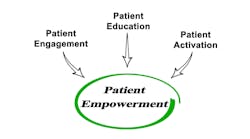What Are the Right Buttons to Push for Enhanced Patient Engagement?
At the 2019 Mid-Atlantic Health IT Summit this week, presented by Healthcare Innovation, industry leaders discussed how patient engagement initiatives—both digitally-enabled and not—are becoming paramount to the evolving healthcare landscape.
On a June 3 panel discussion that included Adam Cherrington, research director, clinical research, KLAS Enterprises, Tara Matthews, deputy CIO, Philadelphia-based Einstein Healthcare Network, and Aaron Kur, vice president, sales, at medical imaging solutions company Ambra Health, Mark Hagland, the moderator of the panel and Editor-in-Chief at Healthcare Innovation, posed a variety of questions regarding patient engagement best practices and how technology can aid in organizations’ efforts. Below are excerpts of that panel conversation.
Hagland: What we call patient engagement is becoming something important, whereas it used to be softer and squishier. But as we move value-based care forward, we are in a different place now. All of us have the motivation to get patients engaged now, right?
Matthews: Our organization has always been thinking about the patient. We want to engage them and do what’s best for them. We just haven’t been sure exactly how to do that, but now that it’s a [federal] mandate, we are focusing more on what it takes to engage patients and the strategies that are needed there.
Kur: From the vendor perspective, there is an inflection point in terms of the infrastructure of clinical applications. What’s happening with patients being able to access the right data and control it themselves? In some ways, it’s happening outside of the hospital in terms of the number of steps you are taking, for example. So providers need the right infrastructure in order to be able to know about those data points. Once you have that data, it allows for the emergence of new technologies and applications.
Hagland: I recall one [health system] giving a recent presentation about a consumer-facing app they developed that aimed to influence behaviors while connecting with care management. For the app, they worked with restaurants and grocery stores so that patients with chronic diseases could find nutritional values of dishes online to help guide their meal choices. So you have patients being engaged because it flows into how their lives work and what their own goals are. How important is it to work with patients to understand their specific goals?
Cherrington: By involving the patients and helping them, and by including their goals in your strategies, you are involving the most critical partner and stakeholder. In the past, patients would go to caregivers and say to them, ‘Tell me what to do and I’ll do it.’ But now with online research, patients are starting to ask, ‘What can I bring to the discussion?’ And we have to involve patients from day one.
Hagland: Accountable care organizations (ACOs) attempt broad health risk assessments of their populations and put the [high-risk patients] in care management programs. Technology can help because if you can engage the right people you can improve their outcomes, right?
Matthews: Throwing tools and technology might not always be the right or first answer. Yes, we need decision support tools so we can see who those [high-risk] patients are, but we really need to listen to the patient. Your whole organization needs to be patient-centric by understanding their needs and goals. What kind of technology are patients using? What community resources do they use? What are other people in their network circle using? Handing them an app on their phone doesn’t necessarily mean they are engaged.
Kur: A recent project from radiologists at Stanford Children's Health who were working on certain chronic conditions involved showing patients their medical images, and the work revealed that actually showing patients their data and their own bodies, and what’s happening to them, can be a powerful motivator.
Hagland: Will the use of consumer-facing wearables help move things forward?
Cherrington: It’s about aggregating the data, segmenting the population and targeting them. So you have your chronic patients with multiple conditions and then those who just have episodic issues. There is a place for apps and devices in both camps. Remote patient monitoring and telehealth tools have a different end goal than the goals of patients who see their doctor once every two years. So you have to define individual goals.
Hagland: Engaging patients’ families is also a key element, as is true team-based care where a patient is part of that team. What does that landscape look like to you?
Matthews: My father had a stroke when I was 16, and my mother had one later on, so I feel like I have been a caretaker my whole life. But it was never a team effort. Physicians, nurses and therapists might all tell you different things. No one was talking to one another. Now, I finally get a care team to talk to, but we aren’t where we need to be; we still have silos. From a technology standpoint, I have clinicians and different business units wanting to buy that new shiny object, and I [often] have to tell them to take a step back, think about what it will achieve and how it will help the entire patient engagement strategy.
Hagland: As a provider, what would you like in terms of partnerships with the vendor community?
Matthews: I will get vendors telling me to buy this product or that one, but I would love them to be true partners and explain how it will really help me show those successful outcomes, rather than trying to just sell me something. And when I finally do make a decision to go with the product, will you stick with us to help implement it, and stay throughout the journey so the product provides the outcomes that you said it would?
Cherrington: A lot of providers are coming to us and asking, which vendor is able to do these 10 different things? Just recently at KLAS we were asking what the key elements of patient engagement should be, and then we took a step back and decided we wanted the market to tell us that. But what’s top of mind? I would say high levels of communication, simplifying the billing process, simplifying access to my provider, and scheduling.
I talked to a provider two weeks ago and [his organization] decided to give a test group of patients a clinician’s phone number. That’s all they did—just give out the phone number. The readmissions from this group went from 100 percent to 0. Now, keep in mind there was only about a dozen patients in the sample, but that 24/7 access represented a new approach to a technology that already existed.
Hagland: How can you figure out the precise technology that will work for a certain need?
Kur: With respect to imaging, we focus on one specific set of patient engagement workflows, and that’s image-enabled patient portals so patients could have electronic access to their medical images. Our [solution] enables patients to send images to providers for second opinions. At most places today you are still getting CDs burned when you need a copy of your [imaging] data. And if you are getting bad news about your health, the last thing you want to do is go drive to some basement and pay for your record and then go drive to deliver that data to the [next provider].
Matthews: We do have apps to push out to patient, and we have remote monitoring, but we are also out there partnering with community centers and churches, because when you go out to the community you will find folks who sit in the centers simply because they’re lonely.
Hagland: How can patient engagement strategies be better developed to become more comprehensive and holistic?
Cherrington: Most organizations are trying to get past the stage of patient portal use for the purposes of Meaningful Use ‘check the box’ requirements. Three or four years ago, when I would ask healthcare organizations about their patient engagement strategy, they’d say we have a portal. And yes, that’s an effort, but when I asked them what percentage of patients are using the portal, rarely would the response be over 20 percent. The portal still has a place, and most of the time you choose one through your EHR. We do need to make sure that solutions are not a departmental approach, but rather more holistic. At KLAS, we do advise vendors as well on what their customers are saying about them. The most successful vendors are not selling their customers a car; they’re teaching them how to drive.
We also interviewed the first original 13 health systems that took on the Apple Health Record solution and we got a variety of responses as far as what their ultimate goals were. Some told us that taking on this initiative allows them to look like a progressive group, which helps with marketing. Others were saying as their patients come to us and request the Apple [solution], we will give it to them. And these were the first 13 health systems. Most organizations believed that this would eventually stick, but also that it would take 12 to 18 months to really get going.


